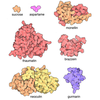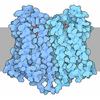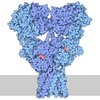[English] 日本語
 Yorodumi
Yorodumi- EMDB-70737: Structure of the sweet receptor bound to advantame in the loose s... -
+ Open data
Open data
- Basic information
Basic information
| Entry |  | |||||||||
|---|---|---|---|---|---|---|---|---|---|---|
| Title | Structure of the sweet receptor bound to advantame in the loose state, extracellular domain | |||||||||
 Map data Map data | ||||||||||
 Sample Sample |
| |||||||||
 Keywords Keywords | Membrane protein / GPCR / SIGNALING PROTEIN | |||||||||
| Function / homology |  Function and homology information Function and homology informationClass C/3 (Metabotropic glutamate/pheromone receptors) / Sensory perception of sweet, bitter, and umami (glutamate) taste / sweet taste receptor complex / detection of chemical stimulus involved in sensory perception of sweet taste / sweet taste receptor activity / taste receptor activity / sensory perception of umami taste / sensory perception of sweet taste / G alpha (i) signalling events / Class C/3 (Metabotropic glutamate/pheromone receptors) ...Class C/3 (Metabotropic glutamate/pheromone receptors) / Sensory perception of sweet, bitter, and umami (glutamate) taste / sweet taste receptor complex / detection of chemical stimulus involved in sensory perception of sweet taste / sweet taste receptor activity / taste receptor activity / sensory perception of umami taste / sensory perception of sweet taste / G alpha (i) signalling events / Class C/3 (Metabotropic glutamate/pheromone receptors) / positive regulation of cytokinesis / G protein-coupled receptor activity / Sensory perception of sweet, bitter, and umami (glutamate) taste / G alpha (i) signalling events / receptor complex / G protein-coupled receptor signaling pathway / Golgi apparatus / membrane / plasma membrane Similarity search - Function | |||||||||
| Biological species |  Homo sapiens (human) / Homo sapiens (human) /  | |||||||||
| Method | single particle reconstruction / cryo EM / Resolution: 3.11 Å | |||||||||
 Authors Authors | Wang H / Chen X / Dai Y / Lee CH | |||||||||
| Funding support |  United States, 1 items United States, 1 items
| |||||||||
 Citation Citation |  Journal: Cell Res / Year: 2025 Journal: Cell Res / Year: 2025Title: Structure and activation mechanism of human sweet taste receptor. Authors: Haolan Wang / Xiao Chen / Yaxin Dai / Shabareesh Pidathala / Yiming Niu / Chen Zhao / Siyu Li / Liang Wang / Chia-Hsueh Lee /  | |||||||||
| History |
|
- Structure visualization
Structure visualization
| Supplemental images |
|---|
- Downloads & links
Downloads & links
-EMDB archive
| Map data |  emd_70737.map.gz emd_70737.map.gz | 36.3 MB |  EMDB map data format EMDB map data format | |
|---|---|---|---|---|
| Header (meta data) |  emd-70737-v30.xml emd-70737-v30.xml emd-70737.xml emd-70737.xml | 20.1 KB 20.1 KB | Display Display |  EMDB header EMDB header |
| Images |  emd_70737.png emd_70737.png | 65 KB | ||
| Filedesc metadata |  emd-70737.cif.gz emd-70737.cif.gz | 7 KB | ||
| Others |  emd_70737_half_map_1.map.gz emd_70737_half_map_1.map.gz emd_70737_half_map_2.map.gz emd_70737_half_map_2.map.gz | 35.6 MB 35.6 MB | ||
| Archive directory |  http://ftp.pdbj.org/pub/emdb/structures/EMD-70737 http://ftp.pdbj.org/pub/emdb/structures/EMD-70737 ftp://ftp.pdbj.org/pub/emdb/structures/EMD-70737 ftp://ftp.pdbj.org/pub/emdb/structures/EMD-70737 | HTTPS FTP |
-Validation report
| Summary document |  emd_70737_validation.pdf.gz emd_70737_validation.pdf.gz | 837 KB | Display |  EMDB validaton report EMDB validaton report |
|---|---|---|---|---|
| Full document |  emd_70737_full_validation.pdf.gz emd_70737_full_validation.pdf.gz | 836.6 KB | Display | |
| Data in XML |  emd_70737_validation.xml.gz emd_70737_validation.xml.gz | 11.3 KB | Display | |
| Data in CIF |  emd_70737_validation.cif.gz emd_70737_validation.cif.gz | 13.4 KB | Display | |
| Arichive directory |  https://ftp.pdbj.org/pub/emdb/validation_reports/EMD-70737 https://ftp.pdbj.org/pub/emdb/validation_reports/EMD-70737 ftp://ftp.pdbj.org/pub/emdb/validation_reports/EMD-70737 ftp://ftp.pdbj.org/pub/emdb/validation_reports/EMD-70737 | HTTPS FTP |
-Related structure data
| Related structure data |  9oq3MC  9opwC  9opxC  9opyC  9opzC  9oq0C  9oq1C  9oq2C  9oq4C  9oq5C  9oq6C M: atomic model generated by this map C: citing same article ( |
|---|---|
| Similar structure data | Similarity search - Function & homology  F&H Search F&H Search |
- Links
Links
| EMDB pages |  EMDB (EBI/PDBe) / EMDB (EBI/PDBe) /  EMDataResource EMDataResource |
|---|---|
| Related items in Molecule of the Month |
- Map
Map
| File |  Download / File: emd_70737.map.gz / Format: CCP4 / Size: 38.4 MB / Type: IMAGE STORED AS FLOATING POINT NUMBER (4 BYTES) Download / File: emd_70737.map.gz / Format: CCP4 / Size: 38.4 MB / Type: IMAGE STORED AS FLOATING POINT NUMBER (4 BYTES) | ||||||||||||||||||||||||||||||||||||
|---|---|---|---|---|---|---|---|---|---|---|---|---|---|---|---|---|---|---|---|---|---|---|---|---|---|---|---|---|---|---|---|---|---|---|---|---|---|
| Projections & slices | Image control
Images are generated by Spider. | ||||||||||||||||||||||||||||||||||||
| Voxel size | X=Y=Z: 1.4422 Å | ||||||||||||||||||||||||||||||||||||
| Density |
| ||||||||||||||||||||||||||||||||||||
| Symmetry | Space group: 1 | ||||||||||||||||||||||||||||||||||||
| Details | EMDB XML:
|
-Supplemental data
-Half map: #2
| File | emd_70737_half_map_1.map | ||||||||||||
|---|---|---|---|---|---|---|---|---|---|---|---|---|---|
| Projections & Slices |
| ||||||||||||
| Density Histograms |
-Half map: #1
| File | emd_70737_half_map_2.map | ||||||||||||
|---|---|---|---|---|---|---|---|---|---|---|---|---|---|
| Projections & Slices |
| ||||||||||||
| Density Histograms |
- Sample components
Sample components
-Entire : Human TAS1R2 and mouse TAS1R3 sweet receptor bound to advantame
| Entire | Name: Human TAS1R2 and mouse TAS1R3 sweet receptor bound to advantame |
|---|---|
| Components |
|
-Supramolecule #1: Human TAS1R2 and mouse TAS1R3 sweet receptor bound to advantame
| Supramolecule | Name: Human TAS1R2 and mouse TAS1R3 sweet receptor bound to advantame type: complex / ID: 1 / Parent: 0 / Macromolecule list: #1-#2 |
|---|
-Supramolecule #2: TAS1R2
| Supramolecule | Name: TAS1R2 / type: complex / ID: 2 / Parent: 1 / Macromolecule list: #1 |
|---|---|
| Source (natural) | Organism:  Homo sapiens (human) Homo sapiens (human) |
-Supramolecule #3: TAS1R3
| Supramolecule | Name: TAS1R3 / type: complex / ID: 3 / Parent: 1 / Macromolecule list: #2 |
|---|---|
| Source (natural) | Organism:  |
-Macromolecule #1: Taste receptor type 1 member 2
| Macromolecule | Name: Taste receptor type 1 member 2 / type: protein_or_peptide / ID: 1 / Number of copies: 1 / Enantiomer: LEVO |
|---|---|
| Source (natural) | Organism:  Homo sapiens (human) Homo sapiens (human) |
| Molecular weight | Theoretical: 92.842008 KDa |
| Recombinant expression | Organism:  Homo sapiens (human) Homo sapiens (human) |
| Sequence | String: AENSDFYLPG DYLLGGLFSL HANMKGIVHL NFLQVPMCKE YEVKVIGYNL MQAMRFAVEE INNDSSLLPG VLLGYEIVDV CYISNNVQP VLYFLAHEDN LLPIQEDYSN YSSRVVAVIG PDNSESVMTV ANFLSLFLLP QITYSAISDE LRDKVRFPAL L RTTPSADH ...String: AENSDFYLPG DYLLGGLFSL HANMKGIVHL NFLQVPMCKE YEVKVIGYNL MQAMRFAVEE INNDSSLLPG VLLGYEIVDV CYISNNVQP VLYFLAHEDN LLPIQEDYSN YSSRVVAVIG PDNSESVMTV ANFLSLFLLP QITYSAISDE LRDKVRFPAL L RTTPSADH HIEAMVQLML HFRWNWIIVL VSNDTYGRDN GQLLGERVAR RGICIAFQET LPTLQPNQNM TSEERQRLVT IV DKLQQST ARVVVVFSPD LTLYHFFNEV LRQNFTGAVW IASESWAIDP VLHNLTELRH LGTFLGITIQ SVPIPGFSEF REW GPQAGP PPLSRTSQSY TCNQECDNCL NATLSFNTIL RLSGERVVYS VYSAVYAVAH ALHSLLGCDK STCTKRVVYP WQLL EEIWK VNFTLLDHQI FFDPQGDVAL HLEIVQWQWD RSQNPFQSVA SYYPLQRQLK NIQDISWHTI NNTIPMSMCS KRCQS GQKK KPVGIHVCCF ECIDCLPGTF LNHTEDEYEC QACPNNEWSY QSETSCFKRQ LVFLEWHEAP TIAVALLAAL GFLSTL AIL VIFWRHFQTP IVRSAGGPMC FLMLTLLLVA YMVVPVYVGP PKVSTCLCRQ ALFPLCFTIC ISCIAVRSFQ IVCAFKM AS RFPRAYSYWV RYQGPYVSMA FITVLKMVIV VIGMLATGLS PTTRTDPDDP KITIVSCNPN YRNSLLFNTS LDLLLSVV G FSFAYMGKEL PTNYNEAKFI TLSMTFYFTS SVSLCTFMSA YSGVLVTIVD LLVTVLNLLA ISLGYFGPKC YMILFYPER NTPAYFNSMI QGYTMRRD UniProtKB: Taste receptor type 1 member 2 |
-Macromolecule #2: Taste receptor type 1 member 3
| Macromolecule | Name: Taste receptor type 1 member 3 / type: protein_or_peptide / ID: 2 / Number of copies: 1 / Enantiomer: LEVO |
|---|---|
| Source (natural) | Organism:  |
| Molecular weight | Theoretical: 92.648562 KDa |
| Recombinant expression | Organism:  Homo sapiens (human) Homo sapiens (human) |
| Sequence | String: ASLCLSQQFK AQGDYILGGL FPLGSTEEAT LNQRTQPNSI PCNRFSPLGL FLAMAMKMAV EEINNGSALL PGLRLGYDLF DTCSEPVVT MKSSLMFLAK VGSQSIAAYC NYTQYQPRVL AVIGPHSSEL ALITGKFFSF FLMPQVSYSA SMDRLSDRET F PSFFRTVP ...String: ASLCLSQQFK AQGDYILGGL FPLGSTEEAT LNQRTQPNSI PCNRFSPLGL FLAMAMKMAV EEINNGSALL PGLRLGYDLF DTCSEPVVT MKSSLMFLAK VGSQSIAAYC NYTQYQPRVL AVIGPHSSEL ALITGKFFSF FLMPQVSYSA SMDRLSDRET F PSFFRTVP SDRVQLQAVV TLLQNFSWNW VAALGSDDDY GREGLSIFSS LANARGICIA HEGLVPQHDT SGQQLGKVLD VL RQVNQSK VQVVVLFASA RAVYSLFSYS IHHGLSPKVW VASESWLTSD LVMTLPNIAR VGTVLGFLQR GALLPEFSHY VET HLALAA DPAFCASLNA ELDLEEHVMG QRCPRCDDIM LQNLSSGLLQ NLSAGQLHHQ IFATYAAVYS VAQALHNTLQ CNVS HCHVS EHVLPWQLLE NMYNMSFHAR DLTLQFDAEG NVDMEYDLKM WVWQSPTPVL HTVGTFNGTL QLQQSKMYWP GNQVP VSQC SRQCKDGQVR RVKGFHSCCY DCVDCKAGSY RKHPDDFTCT PCNQDQWSPE KSTACLPRRP KFLAWGEPVV LSLLLL LCL VLGLALAALG LSVHHWDSPL VQASGGSQFC FGLICLGLFC LSVLLFPGRP SSASCLAQQP MAHLPLTGCL STLFLQA AE TFVESELPLS WANWLCSYLR GLWAWLVVLL ATFVEAALCA WYLIAFPPEV VTDWSVLPTE VLEHCHVRSW VSLGLVHI T NAMLAFLCFL GTFLVQSQPG RYNRARGLTF AMLAYFITWV SFVPLLANVQ VAYQPAVQMG AILVCALGIL VTFHLPKCY VLLWLPKLNT QEFFLGRNAK KAADENSGGG EAAQGHNE UniProtKB: Taste receptor type 1 member 3 |
-Macromolecule #3: advantame
| Macromolecule | Name: advantame / type: ligand / ID: 3 / Number of copies: 1 / Formula: A1CD7 |
|---|---|
| Molecular weight | Theoretical: 458.504 Da |
-Experimental details
-Structure determination
| Method | cryo EM |
|---|---|
 Processing Processing | single particle reconstruction |
| Aggregation state | particle |
- Sample preparation
Sample preparation
| Buffer | pH: 7 |
|---|---|
| Vitrification | Cryogen name: ETHANE |
- Electron microscopy
Electron microscopy
| Microscope | TFS KRIOS |
|---|---|
| Image recording | Film or detector model: GATAN K3 (6k x 4k) / Average electron dose: 60.4 e/Å2 |
| Electron beam | Acceleration voltage: 300 kV / Electron source:  FIELD EMISSION GUN FIELD EMISSION GUN |
| Electron optics | Illumination mode: OTHER / Imaging mode: BRIGHT FIELD / Cs: 2.7 mm / Nominal defocus max: 2.1 µm / Nominal defocus min: 1.1 µm |
| Experimental equipment |  Model: Titan Krios / Image courtesy: FEI Company |
 Movie
Movie Controller
Controller






















 Z (Sec.)
Z (Sec.) Y (Row.)
Y (Row.) X (Col.)
X (Col.)




































